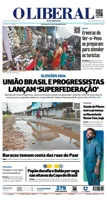Belém has 65% of the territory guarded by 39 islands and uses the green trump to generate money
The urban peculiarity of the Amazon metropolis, today with 1.5 million inhabitants, is that it is the origin of the forest
“On the green cradle of the forest, where so vibrant fauna and flora sprout, you were born, my Bethlehem, between the light breath of the streams and the pleasures of tributary rivers”. The first verses of the anthem of the capital of Pará provide a clue: it is a composition for a city bathed in fresh water. But perhaps even the composer of this anthem, Eduardo Neves, could not have imagined the size of the ecological heritage of the so-called Metropolis of the Amazon, when writing about his inspiration: a Belém that is also formed by an archipelago of 39 islands, rich in biodiversity – and many of which today live with the progressive advance of human occupation, including in areas protected by law, and with an ever greater integration into the urban routine that surrounds them.
Listen to the comment on this news:
And it is this piece of Amazon that forms the majority of the city of Belém. Of the total land in the capital (with 50,582.20 hectares in all), the islands occupy 65.64% of its area, which represents two thirds of all this territory. The other slice, formed by continental lands, is equivalent to 17,378.63 hectares, or the corresponding 34.36% of the municipality.
Today, the capital of Pará has an estimated population of 1.5 million inhabitants. Of these, more than 78,377 people live only in the insular region of Belém (according to 2010 data from IBGE). In 2000, the communities on these islands numbered 58,351 residents. In other words: this city's green frontier experienced a population leap of 20,000 residents in just a decade.
-
Area of the islands: 33,203.57 hectares (65.64% of the territory of Belém)
Belém population: 1.5 million inhabitants
Populations on the islands: 78,377 inhabitants
Sources: CODEM, INCRA (2010), IBGE (2010).
Some islands in the capital entered urbanization stages earlier and have been living together for a longer time with business initiatives in tourism - as is the case of Outeiro and Mosqueiro. Interestingly, the most recent population growth in this island region has focused precisely on the green areas closest to Belém – although, for a long time, these areas have remained protected, surrounded by water, on the other banks of the Pará, Guamá and Bay of rivers. Guajará, which bathes the city. The new occupation movement advances through these natural scenarios, such as in Cotijuba, Ilha Grande and Ilha do Combu, gaining contours different from those of other times, and including new themes and parameters such as sustainability.
"Privilege of Belém being the only capital in the country to have an enormous environmental heritage of unquestionable wealth" - José Mariano Klautau de Araújo, writer and sociologist.
And on other smaller islands, little-known areas continue to be natural treasures even less occupied, with riches in biodiversity. It is not by chance that the late writer and sociologist José Mariano Klautau de Araújo recorded in a publication the importance of the public authorities' view of this region of the capital. In his book “A Dimensão Insular” (1995), Klautau speaks of the “privilege of Belém being the only capital in the country to have an enormous environmental heritage of unquestionable wealth”, citing these islands.
Reasons for late advance
Although the writer is absolutely right, the insular region, which is the largest portion of Belém, is still the most overlooked by public policies in the capital, says doctor in environmental sciences Leila Mourão, a professor at the Federal University of Pará (UFPA). “This was not by chance. The conceptual notion of island brings a symbolic cultural load and representations full of concepts and prejudices in the collective memory, since ancestral times. For a long time, between the 17th and 19th centuries, the islands were used as hiding places for subjugated indigenous people, African slaves and Afro-descendants, or fugitives from justice. Even though the islands made up the areas of the charters and dates of granted land grants, over the first three centuries they were not systematically occupied by land grants”, she explains.
Leila Mourão points out that, in general, until the beginning of the 19th century, some islands in the Metropolitan Region of Belém were used for the cultivation of sugarcane, cocoa, rice, annatto, vanilla, etc. Others became headquarters for potteries and mills. “And even though there were residents on some islands, they were relatively ignored by the government,” she says.
"The islands have become favorite places for the foreign elite and the new rich of latex, chestnut and wood trading" - Leila Mourão, doctor in environmental sciences.
It was only at the end of the 19th century that part of them began to be progressively populated, through government projects and as a result of immigration policies promoted by them, as in Caratateua (Outeiro). The other islands, considered of lesser importance, were occupied by Northeastern migrants, rejected by government projects, or by those who came to the Amazon on their own, without financial conditions to reach the rubber plantations or Brazil nuts.
As a result, it was only at the end of the 19th century, and during the 20th century, that the public authorities began to think about the importance of tourism and leisure for some islands in the Greater Belém region. “The islands of Outeiro, Mosqueiro, Onças, Cotijuba and some others , have become favorite places for the foreign elite and the new rich of latex, chestnut and wood trading. This configures a new social, economic and cultural valuation of the islands, making them economically attractive”, ponders Leila Mourão.
New landscape for the urbanity of Belém
Belém still has many trees. They beautify streets and help to alleviate the region's typical heat. In the more central area, most are secular mango trees - which gave the capital the affectionate nickname of “city of mango trees”. But, over its 405 years, it has been losing more green areas as a result of the occupation process.
In contrast to this urban landscape, the insular area of Belém gained the air of a gateway to refuges. Less than 15 minutes away by boat, one of them offers paradisiacal landscapes, with gastronomic experiences and intense contact with nature: Combu Island, located on the banks of the Guamá River, in Guajará Bay, next to the Island Murutucum, and surrounded by the holes of Benedito and Paciencia. Literally facing the urban landscape, the island is one of the most sought after today, precisely because it is the closest among the 39 islands of the metropolitan island region. It is also the largest of all the new places with growing demand: it has 15.7 km² in length and about 1,800 inhabitants. Plus, it is also an Environmental Protection Area (APA), created by the State of Pará in 1997.
Access to the Combu communities is via the Combu, Periquitaquara, Tapera and Traquateua Igarapés. There are already located there, today, 33 bars and restaurants, linked to the Union of Hotels, Restaurants, Bars and Similar of the State of Pará. Tourismologist Ágila Chaves, a researcher at UFPA, explains this recent flourishing of enterprises on the island: she considers unique the possibilities of tourism in the insular region of Belém, due to the strong presence of nature. “In addition to all the Amazon fauna and flora, the regional characteristics of Pará culture enhance the value chain of local products and the countless forms of use and experiences. All this enriches tourism in Combu and in the other islands of Belém”.
"Among the spatial changes that take place in Combu, restaurants created for leisure and tourism" - Ágila Chaves, tourismologist.
Ágila Chaves recalls that the tourist potential of the insular spaces of Belém is mainly in the strong contact with the rivers. Thus, the islands favor various leisure activities, such as beaches and creeks, the appreciation of cuisine in bars and restaurants, ecological trails and tours on boats such as boats and watercraft, as well as itineraries in historical and archeological sites, camps, events and possibilities purchase of handicrafts and sports activities such as canoeing and stand-up paddle, among many others.
Specifically on the island of Combu, Ágila claims that this new search began a little over a decade ago. “Even though it has been frequented long before, the intensity of tours, opening of bars and restaurants has intensified since 2010. Thus, among the spatial changes that take place in Combu, restaurants created for leisure and tourism, offering services, stand out. and activities such as playgrounds for children, piers for bathing, in addition to ecological trails for those who wish to venture into the island”.
The researcher points out that this tourist and economic potential is confirmed by the increased exploitation of spaces by agencies, but with respect to the daily lives of residents. “Most of these new companies are initiatives of local entrepreneurs, who interact more and more and form more partnerships with the inhabitants of the islands. And that's very good!”, he assesses.
Escape from the city via the Guamá river
Tourismologist Ágila Chaves justifies the increasing passage of residents from the metropolitan region to the islands of Belém. For her, it is a question of a need to escape from the city. “Ilha do Combu regularly attracts visitors from different regions, in search of contact with the fauna, flora and riverside populations. Or even just for the possibility of enjoying moments of leisure and contemplation”.
That's how businessman Rodrigo Reo does, who whenever he can, flees to the other side of the river, in search of the tranquility of Combu. A resident of Belém, he says he feels privileged to have a piece of the forest so close to the capital. Soon, Reo will become a father. And he says he can't wait to take his son to visit the island as well. “Having the opportunity to switch off for a few hours a day, crossing the city, is, without a doubt, a privilege. Not just for me, but for the family, which is growing. Being in contact with nature and showing what is beautiful, so close to home, is already in the plans for the arrival of my first child”, he says, moved.
Taking advantage of the hot July vacation month with her family, university student Amanda Guimarães also prefers the Combu environment to downtown Belém, where she lives. “Every time I come here I feel very good. It doesn't have the pollution and noise of the city. Whenever I can, I come with my family and friends. Even more so, I'm at the end of my graduation. I need more reassurance. That's what I found here.”
"I like my city. She is beautiful, there are many parks. But nothing compares to the beauty we see here at Combu" - Amanda Guimarães, university student.
Businesswoman Anne Porfírio traveled a greater distance to get to know Combu. It was 3.2 thousand kilometers. He left Curitiba, capital of Paraná, towards Belém. And he fell in love with the region of the islands. “I like my city. She is beautiful, there are many parks. But nothing compares to the beauty we see here at Combu. This is the first time I've been here, but I want to plan to come back and bring my husband and my children”, she plans.
Adventure and gastronomy tours come together on the island
To promote tourism in Belém, the Tourism Coordination of Belém (Belemtur) implemented tourist support centers (CATs) in strategic points of the city. In these places, tourism agents must approach, welcome and inform the tourist. "These actions are important in places that are references for tourists. It is a work that is valued all over the world", explains the coordinator of Belemtur, André Cunha.
Currently, five CATs are in operation. One of them is located at Solar da Beira, in the fair and market area of Ver-o-Peso, Belém's best known postcard. The others are on the islands or in tourist spots and access to boarding for trips along the rivers, such as in Ver-o-Rio, in the Hidroviário Terminal in Princesa Isabel square, from where boats depart from Belém to Combu, and in the islands of Mosqueiro and Cotijuba.
It is precisely in the waters of the rivers that the tourism economy is developing in Belém: in waves of adventure, sport, leisure and gastronomic experiences. “The movement to search for outdoor activities has grown a lot. There is a need to connect with nature”, assesses Diego Barros. He is the manager of a company that since 2004 has been promoting ecological tourism in the environmental reserve areas of Belém.
On Combu Island, Diego's group works with an ecological trail that explores the flavors of the original chocolate made in riverside communities. And there are also programs for abseiling at one of the mandatory stops on the island: a tree, from the kapok family, which is 23 meters tall. "Many people are still unaware of the islands, precisely because Belém grew up with its back to them", comments Barros.
But the attractions delight even those from the city. All this in the peculiar setting of a “fantastic tropical chocolate factory”, where you can closely follow the handmade preparation of organic cocoa by Izete dos Santos Costa, 56, the renowned Dona Nena.
In ten years of work, with the help of her collaborators, Dona Nena became the main responsible for highlighting Pará as a strong brand of 100% natural chocolate production, rich in antioxidants and also in stories and respect for the traditional cultivation of riverside dwellers . A delicacy where you can taste, at the same time, a delight and the local culture of the Amazon.
With success, Dona Nena expanded her range beyond gastronomic services. “We started with chocolate. Today we add experience tourism. Visitors start at the waterway terminal, take a tour on the Guamá River, learn about the history of my work, take a trail through the floodplain forest and hear about the importance of preserving it. In the end, we also have the opportunity for each one to make their own chocolate bar with the island's cocoa."
Nena says that the growth of tourism in the region of the islands is beneficial in attracting the attention and investments of the government. However, she warns: it is necessary to take more care of the environment. “Today we already have regular garbage collection, but we need to be more organized. I think it's good to invest in local tourism, but we must look to environmental preservation, in addition to improving our structure so that we can better receive people from outside," she reflects.
The sport practice of canoeing is strengthened in the region, following this same recipe saved by Dona Nena. And so, it gathers more and more fans, among many who are looking for attractions and good reasons to connect with nature. There are several clubs and collectives in Belém for those who explore the rivers and boreholes of the Combu and other islands in the capital, with expeditions that also include social and environmental preservation initiatives, in interaction with riverside dwellers. Currently, Belém also has at least seven initiatives that combine entrepreneurship in adventure tourism, social action and various nautical and exploration modalities, for those who like to enjoy the meeting of the waters with the forest.
Among these expeditions, the most sought after is the one that crosses the Guamá River to the homes of residents who also profit from the tourism chain. One of them is on Ilha das Onças, next to Combu, but belonging to the municipality of Barcarena. “This is the most crowded tour. It's ten kilometers from the mainland to Celso's house, who is a fantastic and very welcoming person. The house and cafe it offers attracts more and more people”, says Luciana Quintana, instructor.
Tourism Economy: Benefits to the Community
An example of the virtuous cycle that the development of tourism already offers to the region of the islands of Belém is in the story of boatman Éder Lima. He is one of those who found in this new opportunities for experiences and guarantees of extra income. Lima worked with the transport of açaí sacks, food and construction material when, four years ago, it began taking tourists across to Combu's restaurants. “This increase in demand for the island has been positive for us residents. Most establishments employ people from here, and this is very good”, he celebrates.
However, despite the good prospects, Anderson Nascimento, vice president of the Association of Riversiders, Boatmen and Conductors of the Islands of Belém, explains that the waters are not that calm for new adventures. The route has already had 30 boatmen working. The number was reduced to 20 during the most critical period of the covid-19 pandemic. That's when the value of the ticket also doubled, from R$ 5 to R$ 10, to reduce the number of people on the islands.
In general, the Executive Superintendence of Urban Mobility of Belém (Semob), a public body responsible for the management and inspection of transport in the city, recalls that the urban waterway transport that connects Belém to its islands is also served by other vessels. They depart from public piers, such as those found in the district of Icoaraci and on the island of Cotijuba - the route that connects the two ports is served by a municipal line that makes the crossing. There are also boats that depart from the Ruy Barata Waterway Terminal, in Princesa Isabel square. There, the crossing to Combu Island is made by two cooperatives of transport workers by boats.
Social entrepreneurship flourishes
The suspension of classroom classes, as a result of the covid-19 pandemic last year, bothered manager Ana de Sá and photographer Grazi Caliman, who had already had a long experience in photography at Combu. Together, one day they decided to embrace social entrepreneurship and establish a headquarters on the island. The space idealized by them adopted geodesic forms - a type of sustainable construction with less waste generation than traditionally built structures. It is within this space, the first geodesic on the island, that 37 children learn to sing and compose the “Canto Coral Combu”, with the support of volunteer music teachers and local residents.
The children assisted by the project have programs held every Sunday morning. “Before, our children had no incentive to get involved in music. Now they are having this contact with musical education. We really liked it,” says Rosimara Silva, a resident of the island and the mother of one of the children served. Rosimara is also one of the project's partners.
In addition to musical education, Canto Coral Combu is also about sustainability, teaching girls and boys to preserve the environment. “The teachers also teach solid waste reuse. We make musical instruments with pet bottles, and the children love it”, says Rosimara.
Ana de Sá, one of the space administrators and creators of the social project, highlights the importance of the business sector investing in tourism on the island. But he emphasizes that it is also important to look at the community, generating education, employment and income for residents. “Many people are not, for example, prepared to work in restaurants. So it is important that entrepreneurs train the local workforce. This is fundamental for the development of this community”.
Residents dream of improvements
It was also through social entrepreneurship that the life of 22-year-old Luanne Silva began to change. Mother, quilombola and riverside, the resident of the Furo do Maracujá, in the region of the islands, this year crossed the gates of the Federal University of Pará (UFPA) as a new freshman. For this, many personal obstacles were overcome, with the help of the Emancipa Network's course, maintained at the UFPA itself, with volunteer teachers.
Today Mateus' mother, age 5, is a student in the Rural Development course. And as the name of the course says, she doesn't just want to change her own life, but also that of her community. "I want to stay here. The course I chose is directly related to environmental issues, with the improvement of rural work”, ponders Luanne.
“I am concerned about the issue of garbage that is not collected here on the island where I live. I wanted to be able to do workshops on how to recycle reusable materials, with children and adults”, plans the university student, who is also concerned with encouraging family farming. “We are extractivists, and it would be very good if we could also plant for our consumption”.
For these, and all other possibilities for conducting their own future, with greater citizenship, empowerment, social well-being and income, the populations of the 39 islands of Belém still face education as one of their greatest challenges. An example of this is in Basic Education. The Municipal Education Secretariat of Belém (Semec) currently maintains ten municipal schools operating throughout the island's insular portion. Of these, five are on Combu Island, where 500 students currently attend.
This year, Semec reconfigured the service provided to schools on the islands. For this, it created the Coordination of Education in the Country, Waters and Forests. Among other objectives, that of reconciling school studies with the lives of different populations and the environments that surround them in the Amazon gains strength. The goal is to guarantee an education that recognizes the land, waters, forests and ethnic-racial territories of the region.
Combu Island: where is it and how to get there
It is the fourth largest in Belém, in size and population.
- 15.7 km² of territorial extension;
- 1800 inhabitants;
- It has been an Environmental Protection Area (APA) since 1997;
- Access via the waterway terminal at Praça Princesa Isabel, in the Condor district, in Belém. The square has parking;
- Departures from the boats: 9 am, daily, with tickets at R$ 10 per person;
- Crossing time: 10 to 15 minutes;
- Tour around the island (50 minutes): R$ 40 per person.
- There are 33 establishments, including hostels, inns, bars and restaurants (open from Tuesday to Sunday, from 10 am to 6 pm);
- Avoid high heels and take a bathing suit to go to the islands.
Sources: Belém Tourist Offer Inventory (2020) and IBGE (2015)
Palavras-chave
COMPARTILHE ESSA NOTÍCIA






































